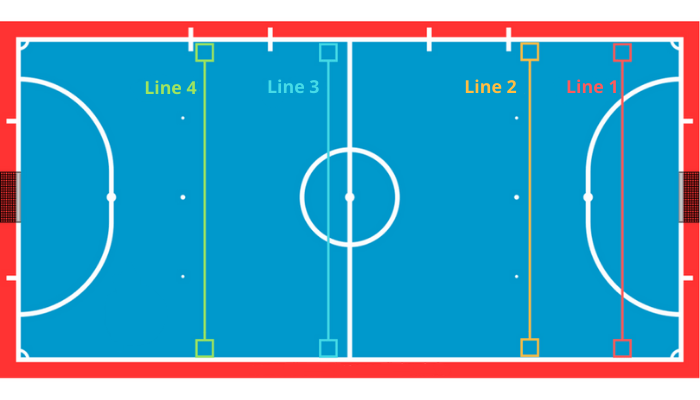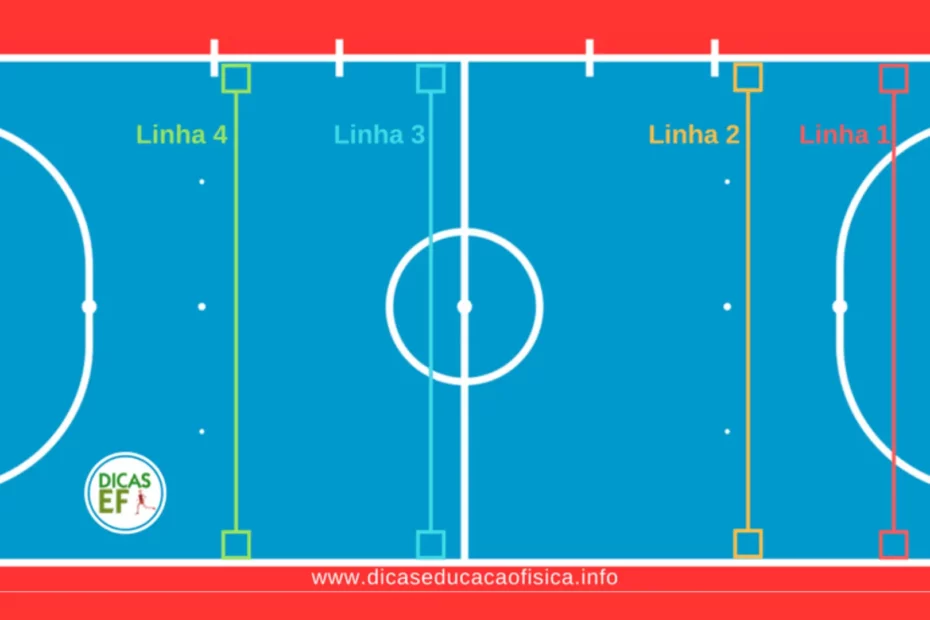Introduction: Futsal’s Defense System
Learn about the Futsal Defense System. Types of defense in futsal: individual marking, zone marking, mixed marking, the lines of defense and the defensive systems of futsal.
Individual Marking in Futsal
Individual marking in Futsal is the popular “each one, mark one”, that is, each player will be responsible for marking a specific player of the opposing team, anywhere on the court where he moves.
The positive points of individual marking are:
-
makes it difficult to kick from a long distance;
-
decreases the passing option;
-
forces the opponent’s error;
-
greater physical wear on the opponents because of the need for greater movement to get out of the marking;
-
decreases the opponent’s time of possession;
-
decreases the opponent’s reaction time to think about what move to make.
Negative points of individual marking:
-
promotes great physical exhaustion of the defenders to accompany the movement of the attackers;
-
leaves the middle of the court open, facilitating throws, infiltrations, and the “balls in the back”;
-
the opposing team may be in a numerical advantage when they get a dribble, making recovery and coverage difficult.
Marking by Zone in Futsal
In Futsal zone marking, each defender is responsible for marking a sector of the court, and the opponent that occupies that sector is the one who will be marked. In zone marking, the defender should not accompany the opponent all over the court, but only accompany the opponents that enter his marking zone. It is a marking used when the opposing team has a good movement with pass exchange or when the team has an advantage on the scoreboard. To perform a good zone marking it is necessary to have a lot of training.
Positive points of zone marking:
-
facilitates coverage and recovery in the case of dribbling;
-
less physical wear and tear on the defenders;
-
provides good possibilities for counterattacks;
-
makes the “ball in the back” difficult and closes the middle of the court well.
Negative points of zone marking:
-
makes it possible to kick from a long distance;
-
increases the ball possession time of the opposing team;
-
can partially obscure the goalkeeper’s vision.
Mixed Marking in Futsal
The mixed marking is one that uses zone marking combined with individual marking, basically it boils down to marking an opponent individually, while the other players are marked by zone.
3×1 Defensive System
The 3×1 defensive system is the marking used against teams that use the 3×1 or 3×2 tactical system. The wings must do the “swing” or the “come and go” like the full backs in field soccer, the pivot must close the middle preventing the ball from being thrown to the opponent’s pivot. If this happens, he should go back to “sandwiching” the opponent, doubling the marking together with his team’s fixed player. The fixed player, besides being worried about the opponent’s pivot, needs to be aware of the other players’ coverage, because he is the last man of defense (SAAD, 2005).
2×2 or Quadrate Defensive System
The 2×2 or Quadrate defensive system is used against teams that play in the 2×2 or 4×0 tactical system. Two players are positioned farther forward and maintain their positions, only leaning on the opponents that “enter” their zone. The two players further back will mark the two most advanced players of the opposing team.
Futsal Defensive Lines and Defensive System
The defensive lines in Futsal are associated with the idea of space; the more advanced the defensive line, the less space is left for the opposing team to play.

First Defensive Line
The first defensive line, or Line 1, is the one made in the opponent’s defense court, near the opponent’s goal, the so-called marking under pressure, with the objective of suffocating the opponent’s ball outlet. In this way, the marking on the first defensive line is a type of marking that leaves little space for the opponent to play.
Second Defensive Line
The second defensive line of Futsal or line 2 is the half pressure marking. In this defensive position, the goalkeeper has a little more space to clear the ball, but as soon as the ball is controlled by an opposing player, the team moves to the first line of defense, increasing the pressure on the marking.
Third Line Defense
The third defensive line of Futsal or line 3 is the half-court marking, because in this defensive positioning the team is positioned from the middle of the court, leaving the opponents unmarked in their defensive court, but when the opponents enter the attacking court, they suffer strong marking. The goal of this defensive positioning is to prevent the infiltration, “ball in the back”, close the middle of the court and play counter-attacks.
Fourth Defensive Line
The fourth line of defense in Futsal, or Line 4, is a type of defensive positioning that is very retracted, made near the 10-meter line in the defense court. In this system, the opposing team will have plenty of space to keep the ball, but no room for infiltration or link-ups. The goal of this defensive positioning is also the counterattacking game.
More Futsal Contents:
- Penalty shootout in Futsal
- Simplifield Futsal Rules
- Blue Card in Futsal?
- Futsal Goalkeeper Rules
- Is allowed to slide tackle in Futsal?
- How Lonk is a Futsal Match
- How many players form a Futsal team
- Futsal Offensive Systems
- Futsal Rules
- Futsal Defensive System
